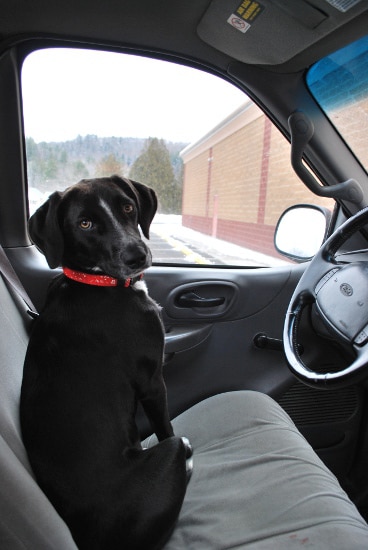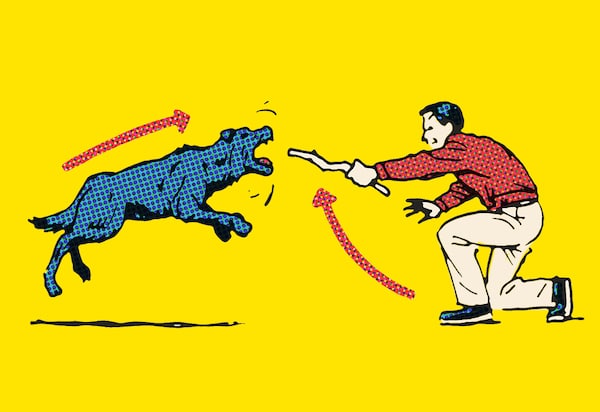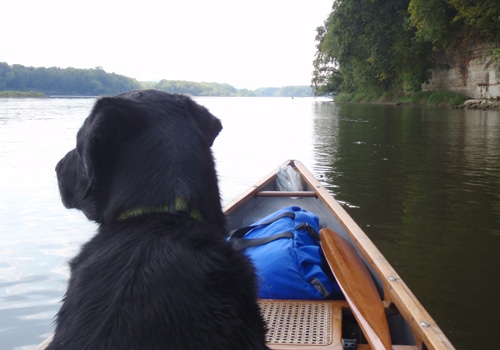Editor’s note: This is a guest post from James “Uncle Buzz” Surwilo.
Several years back, I wrote a piece for the Art of Manliness about having to make the painful decision, then act on that decision, to euthanize our dog, Buddy. The epilogue to that story is that we adopted Danni, who is now closing in on two years old. The operative term here is adopted, not purchased, as I acquired Danni at an animal shelter, rather than buying her from a breeder.
Danni is a mongrel, as every one of the long line of dogs I have cared for or owned have been since my childhood. The first, Mizz, was a street urchin from a dodgy neighborhood who my father coaxed into the car, but subsequent mutts were all sprung from various humane societies or dog pounds near where I lived at the time. My mother was no great animal lover, tolerant of dogs at best, and between her ambivalence and both my parents’ blue-collar conventions, the notion of paying good money to get a recognized breed of dog was completely off the table.
It’s an attitude I’ve carried into my own adulthood, for more reasons than one.
The High Price of Gilded Pooches
If a dog has a job to do — herding sheep, chomping drug dealers, or retrieving waterfowl — I certainly can see the desire for a particular breed. And some folks greatly appreciate the appearance of a certain breed; for instance, the proud and noble German Shepherd or the larval Pug. But if the dog’s occupation is to weigh down the living room rug, and beauty is in the eye of the beholder, then really, what’s in a pedigree?
Every so often I’ll read the local freebie newspaper’s classified advertisements for purebred puppies and I am staggered by the price. I just took a glance a minute ago, and puppies from two different breeds are being offered for $800 each. I do live in the long-ago dreamland of 50-cent cups of coffee and dollar-a-gallon gas, but $800 for a dog? Maybe if it came with a 24-carat gold collar. Otherwise, no thanks.
I’m not going to insinuate that these breeders are not on the level, but busts of puppy mills occasionally make the news even here in Vermont — a state that has both an officious government and a well-earned reputation for neighbors helping — and “spying” on — neighbors. This governmental and social nosiness is bad if you sneak a recyclable can in the trash, but good for sniffing out disreputable dog sellers. So if dog mills are happening here, I have to believe that this sort of nefarious behavior is even more common in other parts of the country where the laws and social fabric are looser. There is no justification for this kind of canine criminality, but it doesn’t take an accountant to understand why puppy mills exist. Think of it: say, eight puppies in a litter, priced at $800 each. That’s a pretty good return on the short-term rental of a stud dog, some deworming medicine, and a few shots. Other than cleaning puppy poop, the bitch does all the work until the pups are ready to go.
The cost of a premium pooch isn’t only extracted from the owner’s wallet either, but from the mutt who gets passed over and left in the pound as well.
No doubt there is data available on the sheer number of dogs in animal shelters, the percentage of them who are adopted, and the unfortunate, and depressing, percentage of dogs that are euthanized. But not having facts to support a conclusion has never stopped anyone from sermonizing on the internet, and it’s not going to stop me! You see, I’m of the mind that purchasing a full-bred puppy for looks or to make an impression has simultaneously sentenced a “pound hound” to death.
Let me explain why, by sharing a little more about how I came to acquire Danni.
Springing Danni from the Big House
A year and a half ago, my best friend Mike and I decided on a couple-day road trip that would take us from his home in rural Virginia to the coal country of West Virginia. The idea was to do some hiking in the hills and hollers, and to poke around some coal mining ghost towns. Also, unbeknownst to my family back in Vermont, I had a notion to come back with a pup from our travels.
On the final day of our West Virginia excursion we detoured miles up a back road to the county animal control center. It appeared, as half-expected, as a long, one-story building placidly set up on a hill, with an entrance on the left and individual kennels extending to the right. When we entered the office, Mike and I were greeted by many meandering cats, constant muffled barking, and a potent odor. The first words out of the harried woman behind the counter were “We can’t accept any more animals!” When I replied that I was looking to adopt a dog, I thought that she was going to kiss me. The assistant said that we could step down the interior passage, which had small dogs and young puppies in the first room, then dogs in kennels on both sides of the hallway beyond the puppy room. Then we could walk outside and look at the dogs in the exterior kennels running down both sides of the building. After that, there were two outbuildings down below holding even more dogs up for adoption. We were free to wander around, and if I saw a pooch that I liked, one of the workers would go fetch him or her, and I could take the prospective adoptee for a stroll.
Neither Mike nor I were prepared for what we experienced. The puppy and small dog room was stacked floor-to-ceiling with small wire cages, like you’d see lab animals in, each holding numerous little mop-haired dogs or just weaned pups. Dozens and dozens. Afterwards we walked down the interior hallway, where every kennel was occupied, with me scanning left and right for a dog who fit my subjective criteria and caught my eye. Only we were being assailed by a chorus of nonstop, deafening barking in a very confined space, which almost made the overpowering odor forgettable. We made it to the end of the hallway and back, but hurriedly, as all our senses were being overloaded. If we couldn’t wait to get out of there, I can’t imagine how distressing it must be for those dogs subjected to the constant resounding noise and confinement.
Next Mike and I circumnavigated the perimeter of the shelter, to view the 60 or so dogs whose kennels faced the outside. And we quickly learned, as if being caged wasn’t upsetting enough to these dogs, the shelter was located next to — very next to — a shooting range, which was going full blast at the time.
Two dogs, one on each side of the exterior kennels, caught my attention in the few seconds that I spent scanning the occupant behind their chain link door, and I made a mental note of the cage numbers, before proceeding down to the two outbuildings. The first stop was a storage building improvised to hold more small dog cages. The second stop was a garage that was pressed into service to hold even more dogs. This situation I found most upsetting. The 20 or so dogs in the enclosed garage were housed in travel crates scattered in no particular order over the floor. Even with the light on, the cages only allowed a bent over, two-dimensional peek at a face, and of course the dogs were howling in that confined space. It just seemed as if these were the forgotten ones, not well represented for patrons, and it was hard to imagine any of them being adopted.
I should make it clear at this point that I have nothing but respect and compassion for the organization that runs this particular shelter. My impression was favorable at the time of my pup’s adoption, observing the small, dedicated staff struggle to simply feed the internees and keep some reasonable level of cleanliness. Since then I have been periodically visiting the shelter’s website and now appreciate the lengths that they go through to raise money to sustain their operation and to see their charges adopted. But the facility is overwhelmed with dogs and cats, treading water against a regional culture that sees no value in spaying or neutering (and, we were told, an overzealous county dog catcher). The facility was simply housing many times the number of animals that it was designed for, or that the staff should be expected to care for.
By the time Mike and I left the garage, we were thoroughly overwhelmed by what we were seeing, hearing, smelling, and feeling. While I was dutifully walking by every cage or kennel, I was on sensory overload, my eyes long glazed over, my head spinning. I could see the grieved look on Mike’s face too. I was expecting a dozen, maybe two dozen dogs to choose from. The selection process would be pleasant and unhurried: take a few prospects out for a walk, a couple of belly rubs, a little pondering, maybe a second test walk, not too different than buying a car. Instead, I had to choose between hundreds of dogs of every age, size, and variety, all in a desperate situation with immense odds against them. We trudged back up to the office — as chaotic and cacophonic as before — and asked to see two dogs, if we may. I had no preference at the time, but for whatever reason I said, “One is in kennel 735,” and that dog was fetched first by the attendant.
Duchess — as she was introduced — was about six months old, smallish, skinny as a rail, black and white, with those droopy ears and puppy dog eyes that melt my heart. She was friendly and affectionate from the initial greeting, without being timid or overly energetic. We took her down to a little pond, maybe 50 yards away. She was interested in us, not so much her freedom from confinement, and walked on a leash well. No obvious red flags. How could I put her back in a cage, walk the other dog, then have to decide between the two and forever wonder the fate of the dog that I didn’t choose? I couldn’t, so in less than three minutes, the decision was made: Duchess was going to Vermont with me.
The shelter staff was thrilled to have a quick and happy ending — and no doubt to free up a premium space. From my recollection, adoption from a Vermont shelter meant much paperwork needed to be filled out, fitness-for-adopting interviews conducted under glaring light, and character references checked. It made the background check for joining the CIA seem effortless. And it’ll cost you a couple hundred bucks to spring that mutt. In this West Virginia shelter, only my scantest personal information was requested and a checkmark indicating that I was a living, breathing human. The standard adoption fee of $20(!) was waived, as the person who reluctantly relinquished Duchess and her sister (whom Mike and I unknowingly walked by at some point) sponsored their adoptions. Consequently, Duchess could cost nothing, although I made a sizable donation.
My new dog climbed into the truck with Mike and I, and together we headed back to her new home in the Green Mountains.
Consider Getting a Pound Hound
It’s likely that many $800 pedigreed dogs are great dogs, but there are so many orphaned and abandoned dogs out there looking for a home, I think it’s immoral to breed more for profit or status. And why pay for a dog’s unconditional love when you can get it — nearly — for free, and do a genuinely good deed in the process?
By adopting Danni — formerly Duchess — for no money and little effort, a dog’s life was saved. Perhaps not just hers, but also the shelter dog that was moved from the oppressive garage to the relatively palatial and conspicuous kennel #735.
Danni has returned the favor many times over. She has pretty amber eyes, a wet nose, a perpetually wagging tail, and a perennially empty belly. She is universally considered “sweet,” a sentiment that the neighborhood dogs, and even cats, would share if they could. The command “speak” befuddles her, but Danni greets me when I come home each day for lunch as if I had been gone for a month, and I react as if I had been.
If any AoM readers are considering acquiring a dog, I recommend the local shelter as the first stop. Somebody there will assuredly steal your heart, just as Danni’s stole mine.








